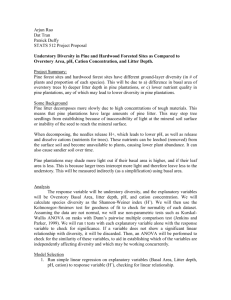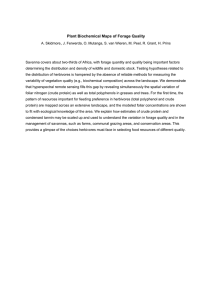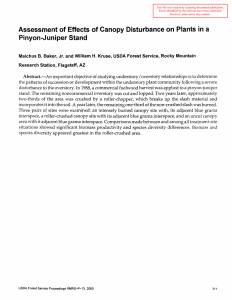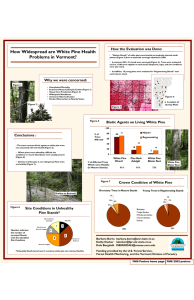INFLUENCE OF PONDEROSA PINE OVERSTORY ON FORAGE QUALITY
advertisement
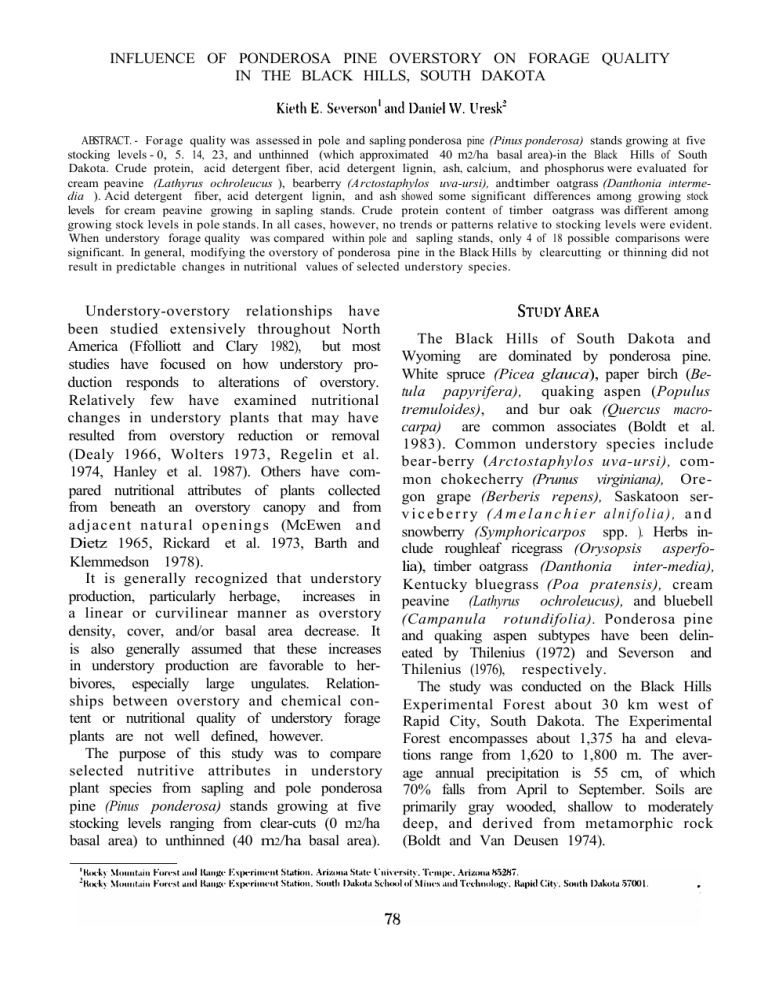
INFLUENCE OF PONDEROSA PINE OVERSTORY ON FORAGE QUALITY IN THE BLACK HILLS, SOUTH DAKOTA ABSTRACT. - For age quality was assessed in pole and sapling ponderosa pine (Pinus ponderosa) stands growing at five stocking levels - 0, 5. 14, 23, and unthinned (which approximated 40 m2/ha basal area)-in the Black Hills of South Dakota. Crude protein, acid detergent fiber, acid detergent lignin, ash, calcium, and phosphorus were evaluated for cream peavine (Lathyrus ochroleucus ), bearberry (A rctostaphylos uva-ursi), and timber oatgrass (Danthonia intermedia ). Acid detergent fiber, acid detergent lignin, and ash showed some significant differences among growing stock levels for cream peavine growing in sapling stands. Crude protein content of timber oatgrass was different among growing stock levels in pole stands. In all cases, however, no trends or patterns relative to stocking levels were evident. When understory forage quality was compared within pole and sapling stands, only 4 of 18 possible comparisons were significant. In general, modifying the overstory of ponderosa pine in the Black Hills by clearcutting or thinning did not result in predictable changes in nutritional values of selected understory species. Understory-overstory relationships have been studied extensively throughout North America (Ffolliott and Clary 1982), but most studies have focused on how understory production responds to alterations of overstory. Relatively few have examined nutritional changes in understory plants that may have resulted from overstory reduction or removal (Dealy 1966, Wolters 1973, Regelin et al. 1974, Hanley et al. 1987). Others have compared nutritional attributes of plants collected from beneath an overstory canopy and from adjacent natural openings (McEwen and Dietz 1965, Rickard et al. 1973, Barth and Klemmedson 1978). It is generally recognized that understory production, particularly herbage, increases in a linear or curvilinear manner as overstory density, cover, and/or basal area decrease. It is also generally assumed that these increases in understory production are favorable to herbivores, especially large ungulates. Relationships between overstory and chemical content or nutritional quality of understory forage plants are not well defined, however. The purpose of this study was to compare selected nutritive attributes in understory plant species from sapling and pole ponderosa pine (Pinus ponderosa) stands growing at five stocking levels ranging from clear-cuts (0 m2/ha basal area) to unthinned (40 m2/ha basal area). The Black Hills of South Dakota and Wyoming are dominated by ponderosa pine. White spruce (Picea glauca), paper birch (Betula papyrifera), quaking aspen (Populus tremuloides), and bur oak (Quercus macrocarpa) are common associates (Boldt et al. 1983). Common understory species include bear-berry (Arctostaphylos uva-ursi), common chokecherry (Prunus virginiana), Oregon grape (Berberis repens), Saskatoon serviceberry (Amelanchier alnifolia), and snowberry (Symphoricarpos spp. ). Herbs include roughleaf ricegrass (Orysopsis asperfolia), timber oatgrass (Danthonia inter-media), Kentucky bluegrass (Poa pratensis), cream peavine (Lathyrus ochroleucus), and bluebell (Campanula rotundifolia). Ponderosa pine and quaking aspen subtypes have been delineated by Thilenius (1972) and Severson and Thilenius (1976), respectively. The study was conducted on the Black Hills Experimental Forest about 30 km west of Rapid City, South Dakota. The Experimental Forest encompasses about 1,375 ha and elevations range from 1,620 to 1,800 m. The average annual precipitation is 55 cm, of which 70% falls from April to September. Soils are primarily gray wooded, shallow to moderately deep, and derived from metamorphic rock (Boldt and Van Deusen 1974). January 1988 S EVERSON, U RESK: METHODS Five growing stock levels (GSLs) of ponderosa pine were sampled. These were numerically designated as 0, 5, 14, 23, and unthinned. Growing stock indicates all living trees in a stand. The numerical designation of growing stock levels approximates, but may not equal, the actual basal area (m2/ha) of the stand. Basal areas of unthinned pole stands ranged from 37 to 40 m2/ha, while unthinned sapling stands ranged from 27 to 33 m2/ha Three replications of each of the five GSLs were established in each of two size classes of pine: saplings (8- 10 cm diameter-breastheight [dbh]) and small poles (15-18 cm dbh). These tree size classes are common and extensive in second-growth forests of the Black Hills. Replicate plots were randomly selected and installed for each of the four GSLs from 5 through unthinned in 1963; the clearcuts (0 GSL) were selected in 1966. Each of the 15 sapling plots was 0.10 ha, and each of 15 pole plots was 0.20 ha. Three common understory species were collected on each plot in August 1976 for analysis. These included one grass, timber oatgrass; one forb, cream peavine; and a shrub, bearberry. Twelve 30 x 61-cm plots were clipped at ground level and bagged by species from each of the 30 GSL plots. Samples were oven-dried to a constant weight at 45 C. All specimens of the above three species from each plot were ground through a l-mm screen Wiley mill, thoroughly mixed together, and composited by plot to obtain samples for analyses. Standard analytical procedures (AOAC 1970) were used for analyses of duplicate subsamples for each plant species and plot. Moisture content was determined by oven-drying samples at 135 C for four hours, cooling in a vacuum desiccator, and reweighing to determine percent moisture. All results were corrected to a dry-weight basis. These samples were placed in a muffle furnace and ashed at 600 C for four hours. Samples were then cooled in a vacuum desiccator and reweighed to determine percent ash. Ash samples were further digested with hydrochloric acid and nitric acid. Calcium content was determined by titrating an aliquot of this mineral solution with ethylenediaminetetracetate acid 79 FORAGE QUALITY (EDTA), using calcein indicator under ultraviolet light. Phosphorus content was determined by measuring optical density on a colorimeter at 440 mu with the addition of ammonium vanadate and sodium molybdate. Standard curves were prepared to correct optical density to milliequivalents of phosphorus per milliliter. Crude protein was determined using micro-Kjeldahl procedures. Acid detergent fiber and acid detergent lignin were analyzed following procedures outlined in AOAC (1972). The null hypothesis-no differences between tree size-classes or among GSLs in nutritional content of selected understory species-was tested with a 2 x 5 (tree size-class x GSL) analysis of variance with three replications per cell. All statistical inferences were made at P = .05. Where differences among GSLs were noted, or a significant tree sizeclass x GSL interaction was detected, sizeclasses were analyzed separately with oneway analysis of variance. Where differences were significant, means were separated using Tukey’s HSD. Because percentage data were used, homogeneity of variances was tested with Bartlett’s Box F. In all cases, Box F was not significant, and so data transformations were not applied. All analyses were done with SPSS/PC+ (Norusis 1986). RESULTS AND DISCUSSION Nutritive contents of understory species were not affected by the overstory 13 years after thinning treatments were applied (Table 1). Some significant differences were noted in the structural compounds (acid detergent fiber and lignin) and ash content of cream peavine from sapling stands, and crude protein content of timber oatgrass in pole stands. In these cases, however, no patterns or trends related to growing stock levels (basal area) were evident. Similar results were noted when stands were compared; in only 4 of 18 possible comparisons were significant differences observed (Table 1). The structural compounds were both higher in bearberry growing under sapling stands. Phosphorus content was higher in both herbaceous species collected from pole-sized stands. However, there were no consistent differences, indicating that tree size, pole vs. sapling, does not have important January 1988 SEVERSON , URESK: thinned stands, but no differences in crude protein or crude fat. Wolters (1973) compared forage growing on longleaf (P. palustris) and slash pine (P. elliottii) plantations in Louisiana to that from cutover areas. While chemical contents were similar the year of treatment, crude protein and phosphorus contents were consistently higher under pine plantations than on cutover land during succeeding years. These differences grew larger as plantations developed (9 years). Nitrogen-free extract was significantly and inversely related to pine basal area during later years; there were no significant changes in crude fat, crude fiber, or calcium. Hanley et al. (1987) did not detect differences in digestible dry matter of two shrubs from very young stands (5-11 years) and adjacent older (80 and about 450 years) Sitka spruce (Picea sitchensis) - western hemlock (Tsuga heterophylla) forest, but did note that plants in young stands had greater astringency, phenolics, and total nonstructural carbohydrates. Those growing beneath older, well-developed overstories had greater concentrations of nitrogen. Similar results have been found where shrubs are overstory. Rickard et al. (1973), for example, found no differences in foliar nitrogen of bluebunch wheatgrass (Agropyron spicatum) growing under and outside the canopy of big sagebrush (Artemisia tridentata). Nor did Barth and Klemmedson (1978) detect differences in nitrogen and carbon percentages in understory vegetation growing under velvet mesquite (Prosopis juliflora) and in the open. Conversely, foliar nitrogen percentage of cheatgrass (Bromus tectorum) collected from beneath canopies of greasewood (Sarcobatus vermiculatus) a n d s p i n y hopsage (Grayia spinosa) was higher than that collected from open areas (Rickard et al. 1973). Examination of studies conducted on areas with a tree harvest treatment (this study, Dealy 1966, Regelin et al. 1974, Wolters 1973, Hanley et al. 1987) reveals considerable variation in response of nutritive attributes to overstory. Nitrogen, or crude protein, for example, was not affected by overstory in South Dakota (this study) and Oregon (Dealy 1966) ponderosa pine, or in Colorado mixed-conifer forest (Regelin et al. 1974), but was in Louisiana pine forests (Wolters 1973) and in Alaska spruce-fir (Hanley et al. 1987). Ash, or total mineral content, was not affected by overstory F ORAGE QUALITY 81 reduction in this study, but higher concentrations were noted in natural or unthinned stands by McEwen and Dietz (1965) and Dealy (1966). Crude fiber (obtained via proximate analysis) cannot be directly compared to acid detergent fiber, but both indicate the least digestible fractions. Responses of crude fiber and acid detergent fiber were extremely variable among studies. Crude fat, however, was not affected by overstory in all instances where it was considered. CONCLUSIONS AND M ANAGEMENT IMPLICATIONS Variable and inconsistent responses of nutrient concentrations in forage plants to changes in overstory indicate that overstory modification cannot be relied upon to obtain predictable changes in nutritional values of individual plant species within interior ponderosa pine forests. However, overstory reduction will increase forage production and forage diversity (Ffolliott and Clary 1982). Therefore, total nutrients can be altered by reducing the overstory, but this results from increased plant production, not from changes in forage quality. Increasing forage diversity creates more and better opportunities for herbivores to encounter higher quality plants or plant parts and thereby improve diet quality. Because ungulates, as a general rule, are selective feeders, by providing the maximum number of forage species, managers would be increasing the opportunities for animals to exercise this selectivity. LIT E RATURE C IT E D A SSOCIATION OF O FFICIAL A GRICULTURAL C HEMISTS (AOAC). 1970. Official methods of analysis. 11th ed. Washington, D.C. A SSOCIATION OF O FFICIAL A GRICULTURAL C HEMISTS (AOAC). 1972. Changes in official methods of analysis. 3d suppl. to 11th ed. Washington, D. C. B ARTH , R. C . AND J. O . K LEMMEDSON . 1978. Shrubinduced spacial patterns of dry matter, nitrogen, and organic carbon. Soil Sci. Soc. Amer. J. 42: 804-809. BOLDT, C. E., R. R. ALEXANDER AND M. J. L ARSON. 1983. Interior ponderosa pine in the Black Hills. Pages 80-83 in R. M. Bums, tech. comp., Silvicultural systems for the major forest types of the United States. USDA For. Serv. Handbook No. 445. USDA, Washington, D.C. 82 GREAT B ASIN BOLDT, C. E., AND J. L. VAN DEUSEN. 1974. Silviculture of ponderosa pine in the Black Hills: the status of our knowledge. USDA For. Serv. Res. Pap. RM-124. Rocky Mt. For. and Range Expt. Sta., Fort Collins, Colorado. DEALY, J. E. 1966. Bitterbrush nutrition levels under natural and thinned ponderosa pine. USDA For. Serv. Res. Note PNW-33. Pacific Northwest For. and Range Expt. Sta., Portland, Oregon. FFOLIOTT, P. F., AND W. P. CLARY. 1982. Understoryoverstory vegetation relationships: an annotated bibliography. USDA Gen. Tech. Rept. INT-136. Intermountain For. and Range Expt. Sta., Ogden, Utah. HANLEY, T. A., R. G. CATES, B. VAN HORNE, AND J. D. MCKENDRICK. 1987. Forest stand-age-related differences in apparent nutritional quality of forage for deer in southeastern Alaska. Pages 9-17 in Proceedings-Symposium on plant-herbivore interactions. USDA For. Serv. Gen. Tech. Rept. INT-222. Intermountain For. and Range Expt. Sta., Ogden, Utah. MCEWEN, L. C., AND D. R. DIETZ. 1965. Shade effects on NATURALIST Vol. 48, No. 1 chemical composition of herbage in the Black Hills. J. Range Manage. 18: 184-190. NORUSIS, M. J. 1986. SPSS/PC+ for the IBM PC/XT/AT. SPSS, Inc., Chicago, Illinois. REGELIN, W. L., O. C. WALLMO, J. NAGY, AND D. R. DIETZ. 1974. Effect of logging on forage values for deer in Colorado. J. For. 72: 282-285. RICKARD, W. H., J. F. CLINE, AND R. O. GILBERT. 1973. Soil beneath halophytes and its influence upon the growth of cheatgrass. Northwest Sci. 47: 213-217. SEVERSON, K. E., AND J. F. THILENIUS. 1976. Classification of quaking aspen stands in the Black Hills and Bear Lodge Mountains. USDA For. Serv. Res. Pap. RM-166. Rocky Mt. For. and Range Expt. Sta., Fort Collins, Colorado. THILENIUS, J. F. 1972. Classification of deer habitat in the ponderosa pine forest of the Black Hills, South Dakota. USDA For. Serv. Res. Pap. RM-91. Rocky Mt. For. and Range Expt. Sta., Fort Collins, Colorado. W OLTERS , G. L. 1973. Southern pine overstories influence forage quality. J. Range Manage. 26: 423-426.

